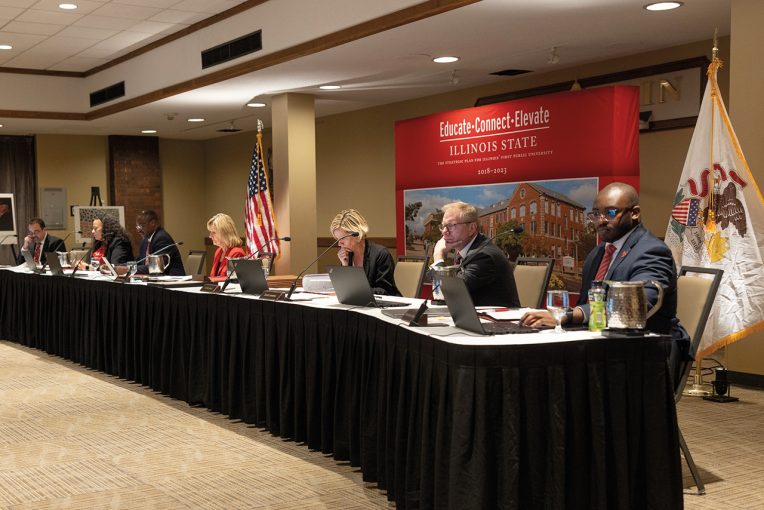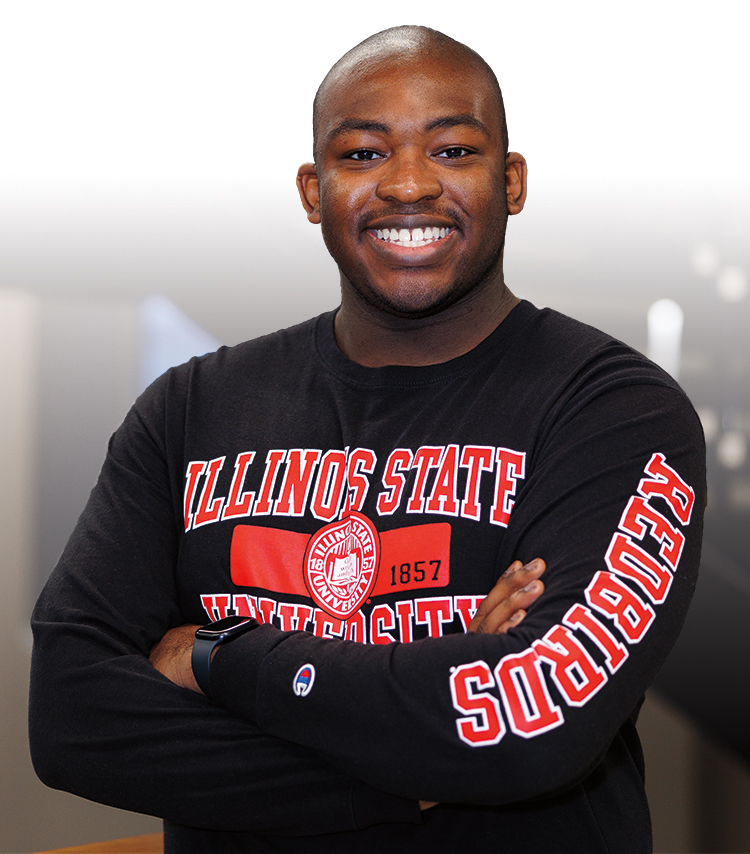Patience Ebikhumi woke early, dressed in a snappy outfit, and prepared for the two-hour drive to Normal. She had never been to a Board of Trustees meeting before.
Appears InWhen she arrived, she found her way to the Old Main Room in the Bone Student Center. She was there to see someone else attending their first board meeting. Her then-20-year-old son, Ash Ebikhumi, was about to be sworn in as the board’s student trustee.
“He didn’t know I was coming,” Patience Ebikhumi said, laughing. “I was so proud. I didn’t know it was such a big deal.”
The first order of business at the board meeting last October was to have Ash Ebikhumi take the oath of office.
“I am incredibly honored to be on the Board of Trustees,” Ebikhumi said after taking the oath. “I’ve only been a Redbird for two years, but I love this campus. I love this community.”
After the meeting, the Ebikhumis visited and took photos. Both wore wide smiles.
“I saw her a couple weeks later, and she had one of those pictures as the background on her phone,” Ash Ebikhumi said. “We have a great relationship, and she’s one of my closest confidants, so I was happy she was there.”
The perspective of 20,000 students
The Board of Trustees is composed of eight individuals who are responsible for ensuring academic quality and fiscal responsibility. Seven are appointed by the Illinois governor and confirmed by the Illinois Senate to serve overlapping six-year terms. The eighth is an enrolled student elected by the student body for a one-year term.
It hasn’t always been that way. The governing body has undergone five major structural changes since the University’s founding in 1857. Perhaps none was so impactful as the shift from a Board of Regents to the modern Board of Trustees.
From 1967 to 1995, under the jurisdiction of the Board of Regents, Illinois State was grouped with Northern Illinois University and Sangamon State University (now the University of Illinois Springfield) based on their similar academic offerings and missions. Decisions impacting all three schools were made by the same governing body.
That changed on January 1, 1996, with the establishment of separate boards for each state university. Two years later, student trustees—who previously played a role on the Board of Regents but were not afforded voting rights—were granted voting privileges.
Former Board Chair Dr. Mary Ann Louderback ’74, M.S. ’80, Ph.D. ’84, who served on the Board of Trustees from 2015 to 2023, described the student trustee as “essential.”
“The student trustees I’ve served with have all been top notch,” said Louderback. “They haven’t been afraid to ask tough questions. That’s what you want.”
A business owner who arrived on the board with background working in government and education, Louderback brought an informed perspective to her trustee role. Each trustee has a unique viewpoint that compliments other trustees, and that’s especially true of the student trustee, Louderback said.
“I strongly believe in having a student on the board,” she said. “That student brings their own perspective plus the perspective of 20,000 students.”
The weight of the position
Ash Ebikhumi was elected student trustee early last fall. A few weeks later, he took the oath of office before a crowded Old Main Room. Officially seated as a member of the board, he and his fellow trustees were tasked with approving a budget of $509.3 million and authorizing the purchase of millions of dollars of goods and services.
On the agenda at the October board meeting were permissions to purchase computers and residence hall furniture, greenlighting a Watterson Towers elevator modernization, and authorizing the renaming of Redbird Arena as part of a sponsorship agreement with CEFCU that will net the University $3.1 million over the next 10 years.
During discussion of the final agenda item, Ebikhumi spoke up.
“I was a little bit intimidated, kind of nervous,” he recalled. “Everything you say in there goes in public record, and everyone is there watching you. So right away, I could feel the weight of the position.”
“It makes you realize that we’re only here for four years, but there are other things happening that are going to last a lot longer than that. And I get to be a part of those decisions.”
—Ash Ebikhumi
In the most discussed of all the agenda items that day, Illinois State Director of Athletics Kyle Brennan was questioned by board members on how the partnership would work and what the sponsorship would mean for Redbird Athletics. Ebikhumi asked Brennan how the sponsorship revenue would be spent.
“I thought it was necessary to get it on the record and make sure they were held accountable for using those funds to benefit the student-athlete experience,” Ebikhumi said. “If I was going to vote in favor of it and they were saying that money was going to be used for mental health and academic support and equipment, I wanted to make sure those promises were clear.”
A rewarding experience
Discussing her experience as a student trustee, Sarah Aguilar ’20 looked around, and it dawned on her.
“Here I am today sitting in a room that was changed because of something I voted on,” Aguilar said from a workstation in the recently renovated Bone Student Center.
It’s been nearly three years since Aguilar was in the role, but the second-year graduate student can still remember the feeling of being a new student trustee.
“It’s intimidating because you are surrounded by people who are well into their professions, and they have vastly different experiences than you,” Aguilar recalled. “But you can learn so much from them. Some of them became mentors to me.”
One of those mentors was Julie Annette Jones ’90, who joined the board a year before Aguilar and later became the first Black woman to serve as board chair.
History of the Board
Over its 166-year history, Illinois State University has been governed by six boards, each unique in name and structure.
Board of Education of the State of Illinois
1857-1917
The first higher education governing board in the State of Illinois was convened informally on March 26, 1857. The longest-lasting of the University’s board structures, it chose Bloomington as the home and Charles E. Hovey as principal of what became Illinois State Normal University.
Normal School Board
1917-1936
Passage of the Civil Administrative Code, intended to streamline state administrative bodies by consolidating and restructuring existing state governing boards, allowed more government oversight of the state’s normal schools.
Teachers College Board of the State of Illinois
1936-1965
The Teachers College Board also operated as a statewide governing board. Most impactful to Illinois State was its authorization of Illinois State’s efforts to become a multipurpose university.
Board of Governors of the State Colleges and Universities of the State of Illinois
1965-1967
Prompted by the Illinois Board of Higher Education, the Teachers College Board of the State of Illinois changed names to reflect the broader scope of some of its institutions. This board governed Illinois State for a shorter span than any other.
Board of Regents of the State of Illinois
1967-1995
With burgeoning doctoral programs, Illinois State and Northern Illinois University were grouped together and governed by a Board of Regents. A third institution—Sangamon State University, now the University of Illinois Springfield—came under the Regents’ jurisdiction in 1970.
Illinois State University Board of Trustees
1995-present
Passage of Senate Bill 241 by the 89th General Assembly of the State of Illinois established separate boards for all state universities. The board is composed of eight individuals. Seven are appointed by the governor and confirmed by the Illinois Senate. The eighth is an elected student.
“I call her my ISU mom,” said Aguilar, the first Hispanic woman to serve as student trustee at Illinois State. “She was very inspirational to me and really provided support, included me, and made me feel welcome. All the trustees were welcoming, but she really took me under her wing.”
Aguilar quickly became comfortable debating decisions with fellow trustees. When she couldn’t build consensus, she wasn’t afraid to dissent. In a vote on an increase in student fees, she cast the lone no vote.
“That’s when it was the hardest—when you could see both sides of it,” Aguilar said. “But you have to stay true to the oath that you took, and that’s to listen to and represent your constituents.”
The board convenes at least four times a year, but there’s more work that goes on behind the scenes. The Open Meetings Act prevents informal meetings of the body, so one-on-one conversations are the norm. It’s a lot of work for no pay, but Aguilar still described her time as student trustee as “one of the most memorable experiences” of her time at Illinois State.
“I’m forever grateful for the opportunity,” she said. “The mentors I had, the experience I gained, and getting to be a part of all the fun stuff—being in the Homecoming Parade and going to events—it was a rewarding experience.”
He does his homework
At the annual Board of Trustees retreat in November, Ebikhumi arrived wearing a coat and tie. A quick survey of the room confirmed he was overdressed.
“Everyone else had on jeans, sweaters, a bit more business-casual,” he said, laughing.
Though he may have encountered some good-natured ribbing because of it, this much was clear to his fellow trustees: Ebikhumi was taking his job seriously.
“It’s fun to just sit and talk with him because he understands the issues,” said Louderback, the board chair. “You can tell he does his homework.”
A junior political science major, Ebikhumi keeps his finger on the pulse of the student body by way of his many roles on campus. He is a director of the Alternative Breaks program, an Honors peer mentor, and a student worker in University Housing Services and the Division of Student Affairs.
“I enjoy being engaged and getting to know people,” he said. “That’s what being a trustee is really all about.”
Though only a few months into his role as student trustee, Ebikhumi understands the board’s work will impact students long beyond his time on campus.
“It makes you realize that we’re only here for four years, but there are other things happening that are going to last a lot longer than that,” he said. “And I get to be a part of those decisions.”


